What Moon Phase is Best for Planting?
When it comes to gardening, every detail matters. From choosing the right soil to providing optimal water and sunlight, gardeners strive to create the best environment for their plants to thrive. One often overlooked factor is the moon phase, which has been believed to play a crucial role in plant growth for centuries. While some might dismiss it as an old wives’ tale, many gardeners swear by planting according to the moon’s phases. In this article, we will explore the different moon phases and determine which is best for planting.
The Moon’s Phases
Before diving into the best moon phase for planting, let’s have a quick overview of the moon’s phases. The lunar cycle consists of eight distinct phases:
- New Moon
- Waxing Crescent
- First Quarter
- Waxing Gibbous
- Full Moon
- Waning Gibbous
- Last Quarter
- Waning Crescent
Each phase lasts approximately 3 to 4 days, resulting in a complete lunar cycle of around 29.5 days.
Lunar Gardening: The Theory
Lunar gardening, also known as gardening by the moon or moon gardening, is based on the belief that the moon’s gravitational pull affects plant growth and vitality. According to this theory, different moon phases influence the movement of sap within the plant, affecting root and leaf development. By aligning your gardening activities with specific moon phases, you can potentially enhance your plant’s health and yield.
New Moon and Waxing Crescent
The new moon phase marks the beginning of the lunar cycle. This is when the moon is not visible in the sky. Traditionally, this phase is seen as the best time for tasks involving below-ground growth, such as planting bulbs, tubers, and root crops. The absence of moonlight during this phase is believed to promote root development and strengthen plants’ foundation. As the moon transitions into the waxing crescent phase, leafy plants can also be planted, taking advantage of the increasing lunar energy.
First Quarter and Waxing Gibbous
During the first quarter and waxing gibbous phases, the moon is gradually becoming fuller. These phases are ideal for planting crops that produce fruits and seeds above ground. As the moon’s gravity strengthens, it is believed to promote leaf and stem growth. Planting during this time may result in strong, vigorous plants with bountiful harvests.
Full Moon
The full moon phase is perhaps the most well-known lunar phase, often associated with mystical folklore and ancient rituals. From a gardening perspective, the full moon is believed to be a time of abundant energy, making it ideal for harvesting crops or transplanting seedlings. Some gardeners also claim that the full moon encourages flowering and ensures a bountiful yield.
Waning Gibbous and Last Quarter
As the moon transitions from full to last quarter, its energy is said to wane. During this period, gardeners typically focus on pruning, weeding, and other activities that minimize growth. It is believed that plants are less likely to experience excessive regrowth or damage during these lunar phases. Additionally, some gardeners use this time to compost and enrich the soil in preparation for the next planting season.
Waning Crescent
The waning crescent phase marks the final stage of the lunar cycle before a new moon. It is often viewed as a resting period in the gardening calendar. During this phase, gardeners might refrain from major planting or pruning activities and allow plants to rejuvenate naturally. It is also an excellent time to focus on soil maintenance and the removal of weeds or pests.
Scientific Evidence
While lunar gardening has been practiced for centuries, scientific evidence supporting its effectiveness remains limited. Most studies on lunar planting have yielded inconclusive results or failed to provide significant empirical evidence supporting the theory. Critics argue that any perceived benefits might simply be due to the gardener’s increased attention and care during specific moon phases.
However, it is essential to note that the moon does affect tides through gravitation, which in turn can impact soil moisture. Some gardeners propose that aligning planting with moon phases could optimize moisture availability for seeds, potentially improving germination rates. Furthermore, the gravitational pull of the moon might influence the movement of fluids within plants, although the extent of this influence is still under debate.
Conclusion
While the scientific evidence surrounding lunar gardening is limited, many gardeners continue to observe the planting calendar according to moon phases. Whether you choose to incorporate lunar gardening practices or remain skeptical, the moon phase can serve as an exciting and ancient tradition in your gardening journey. Ultimately, with careful attention to other essential factors such as soil quality, watering, and sunlight, your plants can thrive regardless of the moon’s position in the sky.
Remember, gardening is a beautifully personal journey, and finding what works best for you and your plants is the most vital aspect of cultivation. So go ahead, experiment with lunar gardening and see if you notice any difference. Happy planting!
Table of Contents
